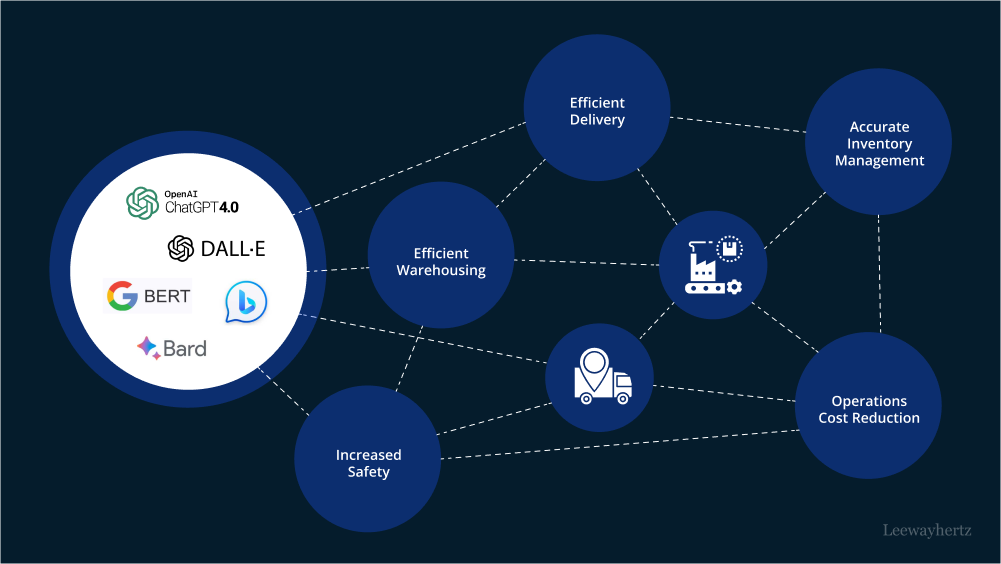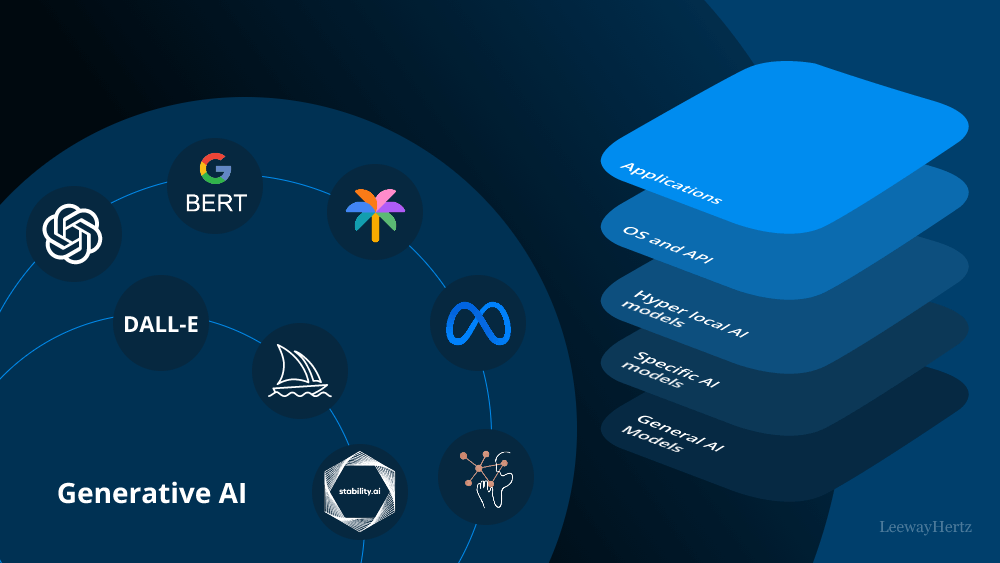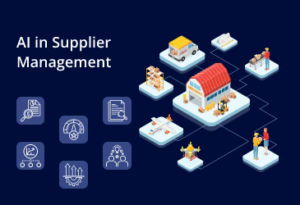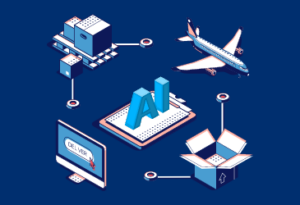Redefining logistics: The impact of generative AI in supply chains

Listen to the article
The global supply chain is continuously evolving, aiming to enhance efficiency, reduce costs, and satisfy customers. However, it faces mounting complexities which stem from escalating customer expectations, rapid market changes, and an intensified call for sustainable methods.
This is where generative AI, a subcategory of artificial intelligence, steps in, providing innovative solutions to tackle these challenges. Through generative AI, supply chain stakeholders can process immense volumes of data, extract valuable insights, and streamline decision-making processes.
In March 2023, a significant stride was made when Microsoft announced Microsoft Dynamics 365 Copilot, an AI-driven assistant incorporated into CRM and ERP systems. Moreover, the release of ChatGPT by OpenAI for public users in November 2022 was a groundbreaking event that paved the way for anyone to explore the potential of generative AI.
The expectations from generative AI in the supply chain sector are high. AI-powered technology facilitates the smooth and sustainable flow of goods, components, and materials in a global, data-driven business environment. According to IDC, by 2026, 55% of Forbes Global 2000 OEMs are projected to have revamped their service supply chains with AI. This will enable businesses to take proactive measures, ensuring a more efficient and smooth supply chain operation. This proactive approach can help prevent delays, minimize downtime, and improve overall supply chain performance.
In recent IDC surveys, global organizations have expressed the need for improved supply chain visibility to mitigate challenges like cost increases and demand volatility. Generative AI holds the capability to fulfill these needs and more, aiding businesses in enhancing their transparency, efficiency, and overall resilience.
In this article, we will delve deeper into the applications and impact of generative AI within the supply chain sector.
- What is generative AI?
- What sets generative AI apart from traditional AI in supply chain applications
- Use cases of generative AI in supply chain
- Demand forecasting and planning
- Inventory optimization
- Managing supplier selection and relationships
- Predictive maintenance
- Optimizing routes and managing logistics
- Fraud detection
- Managing risks and enhancing resilience in the supply chain
- Product design and innovation
- Focusing on sustainability and environmental footprint
- Reverse logistics and returns management
- Financial optimization
- Automating the creation of logistics and customs papers
- How does LeewayHertz’s generative AI platform optimize logistics operations?
- A real-life application of generative AI in supply chains: Microsoft Supply Chain Copilot
What is generative AI?
Generative AI is a type of artificial intelligence technology that focuses on generating new content or data based on patterns it has learned from existing data. Unlike traditional AI models that are designed for specific tasks, generative AI has the ability to create new and original content. The emergence of Generative Adversarial Networks (GANs) in 2014 transformed the field, enabling the generation of realistic images, videos, and audio while raising concerns about deepfakes. Modern generative AI interfaces allow plain language requests, and the generated content can be adjusted based on feedback. They can also generate synthetic data.
Transformers, a type of deep learning architecture, and Large Language Models (LLMs) have been crucial in propelling generative AI into the mainstream. Transformers introduced ‘attention,’ enabling models to comprehend connections across extensive text volumes. Progress in LLMs has led to generative AI creating engaging text, photorealistic images, and even improvising sitcoms.
Despite its growth, generative AI still grapples with challenges like accuracy, bias, and anomalous outputs. However, its potential to reshape industries, from code writing to supply chain transformation, remains promising.
What sets generative AI apart from traditional AI in supply chain applications
Conventional AI methods typically utilize statistical models and historical data analysis. Techniques like time series analysis, regression models, and machine learning algorithms are employed to discern patterns and correlations in historical data. Predictions are made based on identified trends, seasonality, and other data-driven factors.
While these methods are adept at capturing long-term trends and patterns, they often struggle to adapt to abrupt changes or consider external factors not explicitly represented in the historical data. Moreover, they require substantial amounts of accurate historical data for precise forecasting.
Generative AI, however, adopts a different approach. Rather than solely depending on historical data, it creates new data that mirror the training dataset. Generative AI algorithms, such as GANs or Variational Autoencoders (VAEs), learn the underlying patterns and characteristics of the data, utilizing this understanding to generate new data points.
Generative AI possesses an advantage in handling situations where there is a lack of sufficient historical data. In such cases, generative AI can generate synthetic or artificial data points to supplement the existing dataset. This capability is especially valuable when dealing with new products or markets that have limited or no historical data available.
Additionally, generative AI can simulate alternative scenarios and produce “what-if” analyses. This enables businesses to examine different demand scenarios, test the influence of various factors, and make more informed decisions.
Generative AI truly excels in capturing complex relationships and adjusting to dynamic conditions, which sets it apart from traditional AI in supply chain applications.
Use cases of generative AI in supply chain
Demand forecasting and planning
Generative AI in supply chain transforms demand forecasting in supply chain management, enhancing inventory streamlining, reducing product shortages, and elevating customer satisfaction. It applies intricate algorithms to past data, market shifts, and external factors to augment the precision of demand predictions.
The power of generative models lies in their ability to process multiple variables concurrently, unraveling complex patterns and correlations often overlooked by traditional forecasting techniques. This accuracy boosts a business’s ability to anticipate demand changes, optimize production, and adjust inventory levels, driving operational efficiency and financial gains.
The strength of generative AI shines when digesting vast historical sales data, incorporating cyclical changes, marketing drives, and the wider economic climate. As the AI model learns from this rich data, it becomes proficient at generating accurate demand forecasts. The result? Businesses can expertly manage stock levels, allocate resources tactically, and brace for future market trends.
Inventory optimization
Inventory management is a critical balancing act between averting product shortages and mitigating costs associated with excess inventory. Generative AI in supply chain proves pivotal in maintaining this balance, determining optimal inventory levels using analysis of historical data, demand patterns, and external variables. This technology helps businesses to reduce surplus inventory, prevent overstocking, and enhance supply chain responsiveness.
Generative AI models can identify optimal distribution strategies and storage practices considering delivery times, transportation costs, and demand fluctuations. The result is maximized operational efficiency and substantial cost reduction. By proposing to reorder points and safety stock levels, generative AI aids businesses in improving warehouse management, leading to reduced product shortages, minimized surplus inventory, and lower holding costs.
Managing supplier selection and relationships
By analyzing comprehensive data sets, including performance indicators, quality assessments, and cost structures, generative AI in supply chain allows businesses to identify optimal suppliers, thereby enhancing supply chain resilience. Moreover, it aids in proficiently managing supplier relationships by analyzing past interactions, contracts, and performance records. These insights help identify potential risks, improvement areas and propose negotiation strategies, enabling proactive management of supplier-related issues and fostering beneficial collaborations.
Generative AI’s ability to process extensive data like past performance, financial records, and news helps foresee potential disruptions and implement preemptive measures, such as diversifying supplier networks or devising contingency plans. Hence, it helps improve the overall dependability and performance of the supply chain.
Predictive maintenance
Equipment malfunctions and unexpected downtime can significantly disrupt supply chain operations, often leading to considerable financial loss. Generative AI becomes an invaluable asset for implementing predictive maintenance strategies in this context. It achieves this by analyzing information such as sensor readings, historical maintenance documentation, and equipment performance indicators.
Generative AI models can predict when maintenance is needed by identifying data anomalies and patterns. This allows organizations to plan for repairs or replacements proactively, consequently reducing downtime, prolonging equipment life, boosting operational efficiency, and curbing maintenance expenses.
Optimizing routes and managing logistics
Generative AI in supply chain significantly enhances route optimization and logistics management in supply chain operations. It can devise optimal transportation strategies by considering traffic patterns, weather forecasts, vehicle capacities, and customer needs, thereby reducing fuel usage and delivery times and increasing customer satisfaction.
Additionally, it can dynamically adapt to unexpected circumstances in real-time, enhancing overall supply chain resilience. Generative AI analyses extensive data from various sources, aiding in route optimization and transportation, resulting in time and cost savings and overall improvements in logistical efficiency. Its capabilities span route enhancement, vehicle and fleet optimization, and dynamic routing, contributing to a more robust and resilient supply chain.
Fraud detection
Generative AI in supply chain significantly elevates fraud detection in supply chain management by analyzing financial data for irregular patterns indicative of fraud. It uses machine learning algorithms, particularly deep learning neural networks, to examine past transactional data, invoice information, shipping details, and more, spotting anomalies that could signal fraud.
Specifically, Generative Adversarial Networks (GANs) are employed, comprising a generator network creating synthetic fraudulent transactions and a discriminator network identifying them. This dual system enhances fraud detection accuracy.
Additionally, these AI models, equipped with predictive capabilities, can forecast potential fraudulent activities using historical data. This helps detect and proactively prevent fraud, bolstering supply chain security and reliability.
Managing risks and enhancing resilience in the supply chain
Generative AI is a powerful tool for businesses to identify and manage risks within their supply chains. By scrutinizing historical data and external variables such as meteorological conditions, political uncertainties, or disruptions from suppliers, generative AI models can pinpoint potential hazards.
Generative AI models, through their capacity to process substantial volumes of data encompassing past supplier performance, financial statements, and news coverage, can discern patterns and trends associated with supplier-related risks. This enables businesses to assess supplier dependability, foresee possible interruptions, and take preemptive measures to manage risks. Such measures could include diversifying their roster of suppliers or creating contingency strategies, contributing to a more robust and resilient supply chain.
Product design and innovation
Generative AI proves instrumental in advancing product design and innovation by conceiving new ideas, refining product arrangements, and modeling various scenarios. It supports creating inventive and tailored products that meet distinct customer needs while considering supply chain limitations and financial considerations.
Generative AI in supply chain is adept at processing market data, customer opinions, and competitor information to yield insights about potential market gaps or opportunities. This can direct businesses to create new products or services that respond to trends or customer satisfaction standards.
Focusing on sustainability and environmental footprint
Generative AI can significantly promote sustainable supply chain management by refining transportation pathways to decrease fuel usage and emissions. Additionally, it can aid in enhancing the use of packaging materials, cutting down waste, and endorsing environmentally conscious practices across the supply chain.
Technically, generative AI works by analyzing vast amounts of transportation, waste management, and resource usage data. It uses machine learning algorithms to identify patterns and predict outcomes that can lead to more sustainable practices.
In transportation, for instance, generative AI in supply chain can analyze traffic data, vehicle capacities, and delivery routes to optimize logistics and minimize environmental impact. Choosing the most fuel-efficient routes and schedules can reduce carbon emissions and contribute to sustainability goals.
Generative AI can analyze product dimensions, fragility, and other factors for packaging optimization to suggest the most efficient and environmentally friendly packaging solutions. This reduces material usage and waste and can lead to cost savings.
Furthermore, generative AI can analyze resource consumption and waste production data across the supply chain. Identifying inefficiencies and suggesting improvements can help companies adopt greener practices and reduce their environmental footprint.
Reverse logistics and returns management
Generative AI in supply chain can streamline the reverse logistics process, which is a crucial aspect of supply chain management, by evaluating data related to returns, repairs, and refurbishments. This AI technology aids in identifying the best routes for returned products, deciding on repair or disposal actions, and optimizing inventory distribution for refurbished items.
For returned goods, AI can evaluate factors like the cost of transportation, the condition of the product, and the demand for refurbished items. This data can predict whether a product should be repaired, refurbished, recycled, or disposed of. This process helps reduce unnecessary costs and waste.
Regarding routing, generative AI can analyze transportation data to determine the most efficient route for returning products. This can minimize transportation costs and time, resulting in a more efficient reverse logistics process.
Furthermore, for inventory management, generative AI can use historical sales data and demand forecasts to optimize the allocation of refurbished items. This can prevent overstocking or stockouts of refurbished goods and help ensure that these items are allocated where they are most likely to sell, improving overall supply chain efficiency.
Financial optimization
Applying generative AI in financial services and operations offers significant advantages in supply chain management by enhancing efficiency, curtailing risks, and refining decision-making procedures.
Applying generative AI to the financial elements of the supply chain can provide solutions to numerous challenges:
- Credit risk evaluation: Generative AI can process vast quantities of data, including credit histories, financial reports, and market data. This allows for assessing the credit reliability of suppliers, partners, or customers. Supply chain stakeholders can leverage these insights to manage financial risks, make educated decisions about providing credit, and pinpoint potential defaults or disruptions within the supply chain.
- Fraud detection and mitigation: Generative AI models can scrutinize transaction data to identify patterns and irregularities and flag potential instances of fraud within the supply chain. This ability enables businesses to limit financial losses, safeguard their reputation, and uphold the integrity of their supply chain operations.
- Risk management: Generative AI can assess various risks, from currency oscillations and interest rate shifts to geopolitical events. By generating valuable insights, AI can aid businesses in developing strategies to mitigate these risks. This helps supply chain stakeholders manage financial risks more effectively and maintain stability.
Automating the creation of logistics and customs papers
Generative AI holds significant potential in automating the creation of customs and other logistics-related documents, a task traditionally associated with considerable manual effort. This is accomplished by applying Natural Language Generation (NLG), a branch of AI dedicated to creating text that mirrors human writing based on the data or input provided.
The system requires training on an extensive dataset comprising existing customs documents to use generative AI in this context. These documents might encompass a variety of forms, declarations, and regulations, providing the AI with a comprehensive understanding of the specific language, patterns, and structures typically present in such documentation.
Ensuring compliance with the stringent regulations governing these documents is paramount in this process. Precise and accurate generation is crucial to avoid miscommunication or violation of these regulations. Generative AI can maintain compliance across all documents it generates, providing an effective, efficient, and reliable means of automating this crucial aspect of supply chain management.
How does LeewayHertz’s generative AI platform optimize logistics operations?
LeewayHertz’s generative AI platform, ZBrain, plays a transformative role in streamlining logistics processes by significantly enhancing supply chain management, operational efficiency, inventory workflows, and overall logistics optimization. As a comprehensive, enterprise-ready platform, ZBrain empowers businesses to design and implement applications tailored to their specific operational requirements. The platform uses clients’ data, whether in the form of text, images, or documents, to train advanced LLMs like GPT-4, Vicuna, Llama 2, or GPT-NeoX for developing contextually aware applications capable of performing diverse tasks.
Enterprises contend with the complexities of navigating logistics hurdles, including inventory management, supply chain visibility, escalating transportation costs, demand forecasting intricacies, technology integration complexities, last-mile delivery challenges, regulatory compliance intricacies, and data accuracy. ZBrain effectively addresses these challenges through its distinctive feature called “Flow,” which provides an intuitive interface that allows users to create intricate business logic for their apps without the need for coding. Flow’s easy-to-use drag-and-drop interface enables the seamless integration of large language models, prompt templates, and other generative AI models into your app’s logic for its easy conceptualization, creation, or modification.
To comprehensively understand how ZBrain Flow works, explore this resource that outlines a range of industry-specific Flow processes. This compilation highlights ZBrain’s adaptability and resilience, showcasing how the platform effectively meets the diverse needs of various industries, ensuring enterprises stay ahead in today’s rapidly evolving business landscape.
ZBrain’s potent applications elevate logistics operations by transforming complex data into actionable insights, resulting in heightened operational efficiency, advanced predictive analytics, and optimized inventory management. ZBrain’s holistic solutions adeptly address key challenges within logistics processes. Here are some noteworthy examples:
AI-driven demand forecasting
ZBrain employs an automated approach to forecasting demand by extracting pertinent data, including sales history, current inventory levels, market trends, and external factors, such as promotions and economic indicators. This comprehensive dataset serves as the basis for precise forecasting. ZBrain conducts Exploratory Data Analysis (EDA) to unveil insights within the data, identifying missing values, outliers, correlations, and patterns influencing demand. Then, ZBrain transforms textual data into numerical representations using advanced embedding techniques, enhancing forecasting accuracy. When a user queries the demand forecasting report, ZBrain fetches relevant data based on query requirements and processes it using the chosen Large Language Model (LLM) for dynamic report generation. The report, affluent in insights, outlines projected demand scenarios, trends, and influencing factors. ZBrain then expertly extracts essential information, presenting the parsed data in a structured, concise, and accurate format for informed decision-making.
ZBrain applications markedly cut down on time and costs, ensuring precision and enabling superior resource allocation, helping logistics managers optimize warehouse operations. Explore this detailed Flow to understand how ZBrain streamlines demand forecasting and warehouse planning, unlocking unparalleled operational efficiency.
AI-driven fleet management
ZBrain streamlines fleet management and performance monitoring through an automated process. It begins by automatically extracting relevant data, including fleet details, operational data, GPS and telematics data, and maintenance records from diverse sources, ensuring a comprehensive overview of fleet management. Following data collection, ZBrain employs an automated Exploratory Data Analysis (EDA) to find insightful correlations, trends, and outliers within the datasets, providing a deeper understanding of informed fleet management decisions. Utilizing advanced embedding techniques, ZBrain transforms textual data into numerical representations, enhancing analysis efficiency and delivering precise insights for fleet management. When a user queries the fleet management report, ZBrain fetches relevant data based on query requirements and utilizes the chosen Large Language Model (LLM) to generate a comprehensive report. ZBrain parses the report post-generation, extracting critical details. This structured data ensures a coherent and valuable fleet management insight, facilitating strategic and well-informed decisions.
ZBrain applications deliver significant time and cost savings, optimizing fleet management for improved resource allocation and enhanced service levels. Dive into this comprehensive Flow to grasp how ZBrain facilitates seamless fleet management and performance monitoring, ultimately optimizing operational outcomes.
AI-driven route optimization
ZBrain efficiently streamlines delivery routes through an automated process. It commences by automatically gathering essential data for route optimization, including delivery points, distances, traffic conditions, time windows, vehicle capacities, and road restrictions. This comprehensive dataset forms the base for refining delivery routes. Post-data acquisition, ZBrain engages in Exploratory Data Analysis (EDA) to reveal useful insights, identifying patterns and correlations that enhance route efficiency. Advanced embedding techniques are then applied to transform textual data into numerical representations, capturing semantic relationships for efficient analysis and precise route optimization. When a user queries route optimization, ZBrain fetches relevant data and query details, forwarding them to the chosen Large Language Model (LLM) for dynamic report generation. The extracted information undergoes meticulous structuring to ensure precision. ZBrain then compiles all insights into a cohesive final report, showcasing optimized delivery routes, distance comparisons, time reductions, and potential benefits. This consolidated report empowers businesses to implement highly effective route planning strategies.
ZBrain applications elevate delivery efficiency, reducing time and driving cost reductions while enhancing service quality. Explore this detailed Flow to comprehend how ZBrain optimizes route planning, contributing to improving logistics operations.
A real-life application of generative AI in supply chains: Microsoft Supply Chain Copilot
Microsoft Supply Chain Copilot, empowered by generative AI, provides organizations with unmatched visibility and critical insights to anticipate and mitigate potential disruptions.
Copilot leverages generative AI to proactively identify external issues, such as severe weather, financial fluctuations, or geopolitical events, that could impact critical supply chain operations. It offers predictive insights, emphasizing affected orders, and presents a platform for quick action using context-specific email responses.
Supply chain users can collaborate with impacted suppliers to promptly set new delivery timelines and redirect purchase orders if needed. Firms can thus fulfill high-priority customer orders via alternate distribution centers, streamlining operations and saving time.
Its use can address the following problems:
Mitigating risks
Microsoft Supply Chain Center’s Copilot feature uses generative AI to detect potential supply chain issues arising from external factors like weather or geopolitical events. It also provides predictive insights into potential impacts on materials, inventory, and distribution networks.
Using Dynamics 365 Copilot, users can quickly act on these insights, sending context-driven emails to streamline operations and collaborate with affected suppliers. They can promptly set new Estimated Times of Arrival (ETAs), redirect Purchase Orders (POs) due to weather disruptions, or use alternate distribution centers to fulfill orders amidst geopolitical instability. This showcases the efficacy of Microsoft Supply Chain Center’s Copilot in minimizing supply chain risks.
Streamlining order fulfillment processes
Microsoft Supply Chain Copilot, an integral component of the Dynamics 365 Intelligent Order Management (IOM) system, provides businesses with the tools to manage and optimize their order fulfillment procedures. The system applies the power of AI and machine learning to orchestrate fulfillment operations intelligently and automatically. This is achieved through a rule-based framework that leverages real-time data from multiple channels and comprehensive inventory insights.
With this technology, Copilot can refine order fulfillment strategies by automating, identifying and implementing the most efficient fulfillment decisions. Furthermore, the Copilot offers an invaluable feature for enhancing its AI models. In scenarios where the AI’s recommendations fall short of the ideal, the system uses a unique training, feedback, and improvement method to adapt and optimize its decision-making processes continually.
Enhancing forecast precision through collaborative demand planning
Microsoft Supply Chain Copilot, with its AI capabilities, greatly enhances the precision of demand forecasting, an area already employing machine learning. However, due to recent supply chain disruptions, there remains a need for careful manual review, leading to substantial time investments from demand planners in manual analysis and demand plan adjustments.
Next-generation AI models promise to change this landscape. By providing explainable AI forecasts and natural language queries, these models help demand planners accelerate their analyses, shortening adjustment periods from days to just minutes.
Additionally, AI enriches demand review meetings, using natural language for informed decision-making, identifying risks and opportunities, summarizing plan assumptions, providing real-time analyses, and generating meeting transcripts and action items. This new era of AI-in-demand planning aims to make the process more streamlined, accurate, and collaborative.
Leveraging data quality assurance to alleviate order delivery risks
Monthly supplier reviews often involve considerable time and effort as procurement teams gather and analyze performance data. This process can become more efficient with conversational AI.
With Dynamics 365 Copilot, an analyst could request a list of orders not delivered on time and in full (OTIF) in the past month, an estimation of the backlog impact, and recommendations to rectify the issue. The analyst could also ask AI to generate a request for the supplier’s involvement in monthly reviews until their OTIF rate is above 97%. This illustrates how generative AI can democratize data access and retrieval through conversational interactions with AI chatbots.
Moreover, AI can expedite supplier onboarding by fast-tracking internal legal reviews. AI’s assistance in reviewing master supplier agreements could be invaluable to roles such as purchasing managers and supply chain directors.
Harnessing autonomous, self-regulated supply chains
Microsoft’s Supply Chain Copilot leverages advanced AI to transform the complex supply chain management arena. It creates adaptive, automated supply chains that use reinforcement learning to work collaboratively toward improved resilience, profitability, and customer service.
Supply Chain Copilot integrates historical trends and supply chain events to evaluate scenarios, analyze business impacts, and determine optimal strategies. For example, it might propose a combined manufacturing and buying strategy, providing a comprehensive metrics and cost scorecard.
The Copilot system also automates tasks, generates alerts, suggests actions based on exceptions, and learns from user interactions. It enhances decision-making capabilities over time, marking a significant leap forward in intelligent supply chain management.
Intelligent inventory visibility and optimization
Microsoft Supply Chain Copilot’s application allows businesses to optimally balance their inventory, reducing stockouts and enhancing customer satisfaction.
Take, for instance, a scenario where AI predicts an inventory shortage in the following quarter. The root cause is an imbalance between supply and demand in a specific region, further worsened by a scheduled factory maintenance halting production. With Copilot insights, analysts can identify the impacted products and locations and enact corrective measures such as rebalancing inventory from other locations or employing a contract manufacturer.
Moreover, Copilot-enabled inventory visibility is reshaping how businesses manage their stocks, providing users with rapid access to data. Users can quickly check stock levels or product availability by using natural language queries, eliminating the need for complicated navigation or memorization of product details. Additionally, it simplifies data-mining processes and provides easy-to-understand dashboards and text reports, freeing analysts to focus on strategic initiatives.
Endnote
Incorporating generative AI promises to be a game-changer for supply chain management, propelling it into an era of unprecedented innovation. By harnessing the power of generative models, businesses can evaluate various scenarios, model diverse strategies, and fine-tune their decision-making mechanisms. For instance, generative AI could be the key to architecting highly streamlined warehouse layouts, fine-tuning production lines, or formulating creative packaging approaches. Through constant trial and innovation, generative AI equips businesses with the tools to discover novel efficiencies, pinpoint opportunities, and promote ongoing refinement within their supply chains.
As technology continues to advance, the integration and adoption of generative AI will have a significant role in shaping the future of supply chain management, transforming how supply chains are managed, leading to improved competitiveness and sustained growth for businesses.
Unlock superior supply chain efficiency with generative AI solutions. Contact LeewayHertz’s AI experts to transform your operations and drive unparalleled business growth.
Listen to the article
Start a conversation by filling the form
All information will be kept confidential.
FAQs
How does generative AI contribute to supply chain optimization?
Generative AI enhances supply chain optimization by creating synthetic data for simulation, improving demand forecasting accuracy, and providing innovative solutions for complex logistics challenges.
What distinguishes generative AI from traditional AI in supply chain applications?
Generative AI stands out from traditional AI by its ability to create new content, including data and solutions, rather than relying solely on existing patterns. It introduces creativity and innovation into supply chain processes, offering unique solutions to complex challenges.
What are the key use cases of generative AI in supply chain management?
Generative AI in supply chain management offers a paradigm shift by introducing creativity and innovation into traditional processes. Its diverse applications include enhancing demand forecasting and strategic planning, optimizing inventory levels, facilitating supplier selection and relationship management, predicting equipment maintenance needs, optimizing logistics routes, contributing to fraud detection, managing risks, fostering product design innovation, focusing on sustainability and environmental considerations, streamlining reverse logistics and returns management, optimizing financial strategies, and automating the creation of logistics and customs paperwork.
Can generative AI be customized to meet the unique needs of different supply chain models?
Yes, generative AI is highly customizable and adaptable to diverse supply chain models. It can be tailored to address distinct challenges and requirements, ensuring a seamless integration into different supply chain frameworks.
How does generative AI contribute to the overall efficiency of supply chain operations?
Generative AI improves overall supply chain efficiency by optimizing processes, reducing risks, and fostering innovation. It enhances decision-making, minimizes disruptions, and contributes to a more agile and responsive supply chain.
Can generative AI be integrated into existing supply chain systems?
Yes, generative AI is designed for seamless integration into existing supply chain systems. It can work harmoniously with current technologies, enhancing capabilities without disrupting established workflows.
How does generative AI contribute to the overall efficiency of supply chain operations?
Generative AI improves overall supply chain efficiency by optimizing processes, reducing risks, and fostering innovation. It enhances decision-making, minimizes disruptions, and contributes to a more agile and responsive supply chain.
In which areas of the supply chain can LeewayHertz's generative AI solutions bring the most impact?
LeewayHertz’s generative AI solutions can bring significant impact in various supply chain areas, including demand forecasting, inventory management, risk assessment, and route optimization, contributing to enhanced efficiency and innovation.
How can LeewayHertz's generative AI solutions assist in mitigating risks within my supply chain operations?
LeewayHertz’s generative AI evaluates potential risks by creating simulated scenarios, allowing for proactive risk management strategies. Our solutions contribute to identifying vulnerabilities, optimizing contingency plans, and enhancing overall supply chain resilience.
How do generative AI solutions by LeewayHertz contribute to sustainable practices in the supply chain?
LeewayHertz’s generative AI solutions focus on optimizing route planning, reducing environmental impact, and promoting sustainable practices in the supply chain. We prioritize solutions that align with green and sustainable initiatives.
Can LeewayHertz's generative AI solutions be scaled to accommodate the growth of my business's supply chain operations?
Certainly, LeewayHertz designs scalable generative AI solutions, ensuring they evolve with the growth of your supply chain operations. Our solutions are adaptable and capable of handling increased workloads seamlessly.
How does LeewayHertz ensure the security of sensitive data within generative AI applications for supply chains?
Security is a top priority for LeewayHertz. We implement robust encryption access controls and adhere to data protection regulations to safeguard sensitive data within generative AI applications for supply chains.



















